Movie Review - Romeo & Juliet
Romeo & Juliet
October 24, 2013
With well over 150 adaptations and imaginations of what is perhaps Shakespeare’s most famous, and definitely most adapted, work on screen, director Carlo Carlei’s new ROMEO & JULIET is, in a word, masterful. Bringing the grandeur and majesty of Shakespeare and the legendary story of star-crossed love to life in this luminous version, is nothing short of golden - - as in Oscar gold.
Having seen well over 100 incarnations of the story, including shorts that showcase only specific scenes, this ROMEO & JULIET is by far my personal favorite presentation, surpassing the acclaimed 1968 Zeffirelli version as well as George Cukor’s 1936 take starring Norma Shearer as Juliet. One of my fave shorts is the 1908 Italian version done by Mario Caserini while the first attempt at adapting the entire play for film in 1911 by director Barry O’Neill is a valiant effort that falls flat, leading one to prefer the filming of play productions such as the 1924 balcony scene at the Regent Theatre which marked the “film debut” of John Gielgud. (However, just for pure laughs and giggles, if you get a chance to see the 1909 French short that’s played as a comedy, it’s quite a sight to behold.) The 1994 five-part miniseries out of London is an exemplary version (leave it to the Brits) while Baz Luhrmann’s 1996 Leonardo DiCaprio modernization is one to pass over.
While George Cukor’s version was extravagant for the day in terms of cost, the final production values have always felt lacking. Similarly, while Zeffirelli’s film was embraced by audiences and critics alike, when push comes to shove, Olivia Hussey is not that spectacular a Juliet. What sold the film was the fact that she was actually one of the few actresses closer in age to the character Shakespeare wrote; i.e., she wasn’t 25 or 30 trying to be 15. But now we have Hailee Steinfeld who has such age appropriate cherubic innocence and passion that she will make you forget all others. And we have a script adaptation by Julian Fellowes, delivering a ROMEO & JULIET that while true to The Bard’s words, has a beautiful lyricism and flow thanks to some condensing of scenes, making this a ROMEO & JULIET for the 21st century.
Casting is the best and most appropriate I have ever seen for a film/tv production of ROMEO & JULIET. Key is that the young lovers played by Hailee Steinfeld and Douglas Booth are age appropriate and their chemistry is like liquid Mercury. Fluid, mesmerizing, engaging, shining brightly. Steinfeld not only captivates with blossoming innocence but gives Juliet confidence, strength, conviction and intelligence. Booth adds a collegial maturity that is refreshing, fun and adoring in Romeo’s love for Juliet. The genuine adoration that the camera captures in Steinfeld’s eyes when gazing on Booth’s Romeo is heart-stoppingly tender and exquisite. The one admitted challenge for Steinfeld, however, was grasping Shakespeare’s words. “It was definitely a process learning that text and going through and translating each thing. My script was filled with little itty bitty writing and the translation of every line.”
As Romeo’s best friend, Benvolio, Kodi Smit-McPhee just knocks it out of the park in his first “mature” role. Poignant, engaging, heartfelt. Ed Westwick just nails Tybalt with anger and arrogance. The Alan Rickman/”Professor Snape” black hair is a killer element to his whole look, one that matches the venomous vitriol Tybalt spews forth in word and deed. And can we talk fine fine fine looking men? Where has Christian Cooke been hiding? Let’s rewrite the story so that Mercutio doesn’t die just so we can see more of Cooke.
There are no words for the excellence of Paul Giamatti but for these: Best Supporting Oscar Nomination Now! As Friar Laurence, Giamatti brings a welcoming lightness, offsetting the darker moments in the story. Adding to his magic is Lesley Manville as Juliet’s Nurse. Put Giamatti and Manville together and the result is some laugh-warranting exchanges. A delight to watch these two!
Appropriately commanding yet calm is the aura that Stellan Skarsgard gives to the Prince of Verona. But then we have a completely different change of pace with Damian Lewis who just shocks the hell out of you as Lord Capulet when he goes from a smarmy niceness to a ranting bedroom scene with threats of disownment and eviction of Juliet should she not marry Paris (who is a wimp and effectively played that way Tom Wisdom). Lewis will have you shaking in your seat at the seemingly psychotic break.
In this new incarnation from Carlei, we have sweeping grandeur and lushness not only visually, but emotionally. Key is that Carlei and Fellowes “ push back the story 100 years and set it during the Reign of Sons instead of the end of the Dark Age in the other movie, to take advantage of the beautiful buildings and the color palette of the maestros of the Reign of Sons.” With this temporal shift, and thanks to the expertise of cinematographer, David Tatersall, every frame looks like a painting with the initial balcony scene spectacularly framed and lensed; a slow zooming upward pan as Romeo comes toward his love. We are immersed not only in that scene, but in every scene. Tatersall’s use of light and shadow is breathtaking. The corridor in the Capulet crypt with flaming sconces throwing a warm golden glow on the fresco-ed, crackled walls is not only striking but warming, metaphorically showing us that in death there is still life. The Masque Ball fills the screen with 360 degree movement, sweeping the audience into the moment. The break of dawn after the young lovers’ wedding night is white, bright, pure, innocent, soft. Steinfeld’s Juliet is always softly lit, almost as if in the 1930's “cheesecloth” effect during her most adoring moments. Tatersall’s cinematography cries out for an Oscar nomination.
Significant from a visual standpoint, Carlei embraces the cinematic feel that the story itself has, celebrating the visual expansiveness and removing that sense of claustrophobia so often associated with the tale. Creating expanse through the breathtaking architecture of the castles and village itself, capturing wide shots that expand not only our visual horizons, but metaphorically, the emotional horizons that take this story and its core of innocent love, lifting it to the heavens.
The construct of design both visually and emotionally is superlative. Notice that when long staircases are involved, everyone is always running down them, never up. The only real upward movement by an actor is by Booth’s Romeo when he climbs the trellis to the balcony - and again, kudos to Tatersall and Carlei for shooting that with a jib as we are right there with Romeo’s movement - not just bystanders or observers from afar; we are experiencing the anxious shortness of breath as he climbs and his heart races with the excitement of a new love.
The metaphoric contrast of the vastness of rooms and ceilings and the height of ceilings that reach to the heavens (again, prescient for death and heaven for the lovers and the upward climb of young love) set against the confinement of alleys when swordplay and confrontation ensue furthers the tonal and emotional bandwidth of the film and provides an additional unspoken layer of clarity to Shakespeare’s words.
The one shortcoming, however, is the swordplay. Although according to Booth and Smit-McPhee “there was quite a lot of [sword] rehearsal”, the end result is only “fair” in its execution, leading one to believe that perhaps some more sword training was required. However, to Carlei’s benefit, the angular lensing and editing covers some of the inadequacies.
According to screenwriter Fellowes, “We were very keen to appeal to an audience beyond that of Shakespeare’s scholars. We didn’t want to present a story that you needed to be a student of Shakespeare in order to understand it. . .We wanted to keep the feeling there, keep Shakespeare’s intention and keep his language. . .[E]ven though 80% of the movie is Shakespeare, but what it is, is cut. This scene is put maybe with this scene and all the rest of it. So we had this kind of double agenda which was to bring the story to be enjoyed by an audience who have not maybe been to a Shakespeare play every Friday night of the week, but at the same time, to be true to the play.”
A writer very cognizant of the visual aspects of a film, Fellowes expounds. “The great advantage of a movie when you are trying to do that is that you can stay with the visual narrative; you’re not having to go against Shakespeare, you’re following his definition - you’re in the Capulets’ house, you’re in the Prince’s palace, the market square, whatever it is - because he chooses his locations like a moviemaker. For him, you sit one tree on the back of the stage and you’re in the park. You stick a throne in the back and you’re in the throne room. It’s not like with a modern play where you’re trying to get away from that sitting room with a sofa and two chairs that makes you want to cut your throat when the curtain goes up. So that was an advantage that, for me, Carlo really took with both hands and opened it up, staying with Shakespeare’s choice of location but making them real.”
Carlei himself agreed to direct ROMEO & JULIET after reading Fellowes’ script. “. . .[I]t was the most beautiful script I’ve ever read in my life. The trick that this gentleman [Fellowes] used was that by giving very little description, he captured my attention and my heart only through his incredible re-adaptation or recreation of the [dialogue]. It was mesmerizing. The thing was relentless. Sometimes it takes a lot of description to describe an action scene and you lose focus, you get bored by the description. This was like an action movie and you were absolutely blown away.”
As stunning as is the costume design of Carlo Poggioli and the breathtaking production design of Tonino Zera, it the sweeping sumptuous score of Polish composer Abel Korzeniowski that gives ROMEO & JULIET its wings. While no stranger to some, having scored “A Single Man” and Madonna’s “W.E.”, ROMEO & JULIET is without a doubt the crowing glory in Korzeniowski’s repertoire. The score is very much a character in the film, carrying us along, keeping us paced and moving without become trapped or lost in the pentameter of Shakespeare. Lush and smooth, the score is thematic, much like that of Bernard Hermann or Max Steiner or even Korzeniowski’s contemporary, Aaron Zigman. Scoring - another technical aspect of the production that calls for Academy attention.
Hand in hand with the beauty of the score is the sound design that utilizes the music in what feels an intentional construct in the design. When Paul Giamatti speaks, the music fades out. When Skarsgard (who cuts a mean regal figure) speaks, his voice booms and there is no music. When Lesley Manville speaks as the kindly, loving Nurse, there is no music. Yet, when the younger performers such as Steinfeld or Booth speak, quite often the music is elevated, almost as if to cover any slips in their pentamic dialogue delivery. A judiciously interwoven element of the production that maintains the lyrical flow.
What light through yonder breaks? For ROMEO & JULIET, hopefully, the glint of Oscar gold.
Directed by Carlo Carlei
Screenplay by Julian Fellowes based on the play by William Shakespeare
Cast: Hailee Steinfeld, Douglas Booth, Ed Westwick, Paul Giamatti, Damian Lewis, Stellan Skarsgard, Kodi Smit-McPhee, Lesley Manville, Tom Wisdom, Christian Cooke
genre: drama


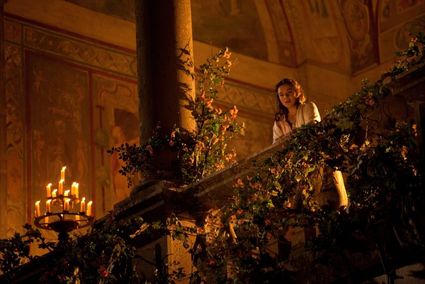


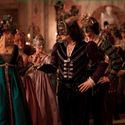
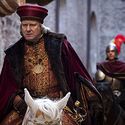

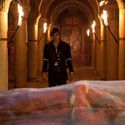
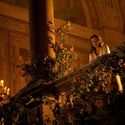


















Reader Comments(0)